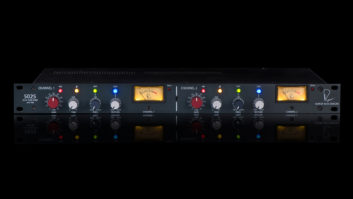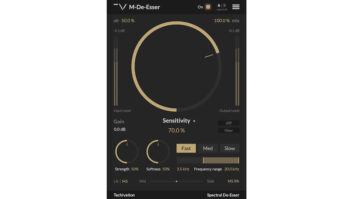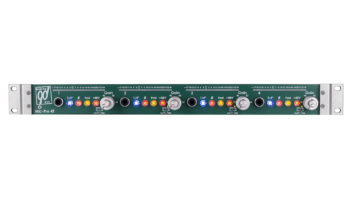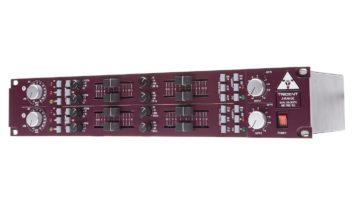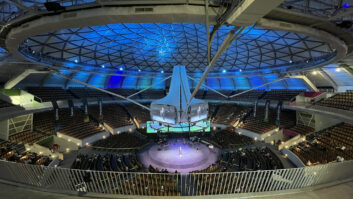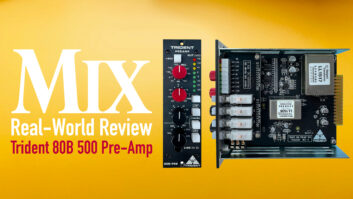
The DME103 Microphone Preamp is manufactured by Frank De Medio, whohas a long history of circuit and console design. In the late 1960s, hepartnered with Wally Heider to design and install numerous consoles inHeider’s Los Angeles and San Francisco studios. His console at SunsetSound in L.A. is one of the best-sounding that I have ever heard. Withthis in mind, I was very interested to hear his new outboardpreamp.
Microphone preamplifiers seem to come in two flavors these days:modern designs with lots of bells and whistles (such as EQ, dynamicsand A/D converters) and vintage designs, which tend to take a moreminimalist approach. The DME103 falls firmly in the vintage categorywith its large knobs, simple chrome switches (for phantom power) andvery familiar-looking VU meters. However, the DME103 is not a replicaof any other preamp. It is a modern design delivered in a vintagebox.
The 103 uses a Jensen input transformer and a differential output.It has a maximum output of 28 dBu (i.e., 24 dB of headroom above“console 0”). The frequency response of the amp is 10 Hz to50 kHz, ±½ dB. The unit I reviewed has a maximum gain of 67dB. It has a four-position stepped attenuator, providing 0, -10, -20and -30 dB of input padding. However, based on feedback from hisclients, De Medio has added two more attenuation positions at -40 and-50 dB. It has a variable level controller with 14 dB of gain. One nice“modern” accent is the LED illumination of the meters— no more replacing incandescent bulbs.
Operating the 103 is simple: Set the attenuator and gain control sothat the VU meter is operating in its normal range, and you’re done.The first test I put the DME103 through was at Sunset Sound.Unfortunately, the room with the De Medio console was undergoingcosmetic renovation, so I was not able to compare the new preamp to theconsole preamp. Working on Studio 2’s 8088 Neve, I set levels and EQ ondrummer “Little John” Roberts’ overhead mics and got apretty nice sound; how can you go wrong with a pair of C-12s and a Neveconsole?
When I changed over to the 103 preamp, the first word out of mymouth was, “Wow!” I was particularly impressed with thesmoothness of the upper midrange. When I went back and forth, the Nevepreamps sounded as if they had sandpaper in them. Don’t get me wrong, Iliked the sound I had dialed up with the Neve pre’s, but the 103ssounded much clearer and more transparent. I also noticed that I wasable to back off the high-end EQ that I was adding to the Neve micpreamps. Because the DMEs already sounded cleaner, I didn’t need asmuch EQ to “open up” the mics.
De Medio claims that he designed his preamp to be completelytransparent, no matter where the input attenuator is set, and that itdoes not color the sound in any way. With the help of a nimble-fingeredassistant, I listened to different settings on the 103, each timematching the volume (with different pad settings) as quickly aspossible. The DME103 input pad is the first I have heard (or not heard)that did not sacrifice audio quality when engaged.
Additional listening tests involved recording a cello and a violinwith a matched pair of Microtech Gefell 296s placed as closely to eachother as possible. The preamps were then level-matched and recordeddirectly to Pro Tools|HD at 192 kHz. I recorded multiple passes, eachtime comparing one channel of the DME103 to one channel of a GML, aMillennia STTI and a Mastering Lab mic pre. The STTI (set on vacuumtube and transformer input) was more pronounced in the upper mids. TheGML was a little warmer or fuller, and the Mastering Lab seemed a bitmore colored, albeit in a good way. All of these microphone preamps aretop-quality units, and the 103 compared very well to them. If I madethe analogy that preamps are like windows through which you view thesound of your mics, I would even go as far to say that De Medio’spreamp is like a window without the glass.
Some things I would like to see on this unit are phase invertswitches and an overload indicator. Although the aluminum case iscertainly strong enough, the unit is quite light and a beefier casewouldn’t hurt.
De Medio calls his preamplifier “nondigital.” The 103’sfrequency response goes well beyond the limits of the brickwall filtersused in A/D converters when operating at standard sampling frequencies.It is designed to faithfully reproduce and amplify analog signals wellbeyond the normal audio frequency range of 20 to 20k Hz.
De Medio describes himself as belonging to the old guard. “Welisten to the high end,” he says. “It has to be clear, ithas to be there and it has to be clean.” After listening to hisDME103, I have to agree that his preamp has achieved those goals.
The DME103 has a suggested list price of $2,500.
De Medio Engineering, 818/768-2296, www.demedioengineering.com.
Erik Zobler grew up in New York, partied in Boulder, Colo.,demonstrated in San Francisco and eventually migrated to Los Angeles,where he learned the ancient art: “The Way of theTonemeister.” You can meditate with him at[email protected].
